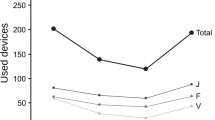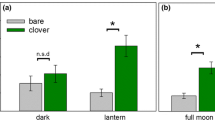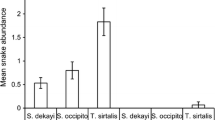Abstract
The foraging decisions of animals are often influenced by risk of predation and by the renewal of resources. For example, seed-eating gerbils on sand dunes in the Negev Desert of Israel prefer to forage in the bush microhabitat and during darker hours due to risk of predation. Also, daily renewal of seed resource patches and timing of nightly foraging activity in a depleting environment play important roles in species coexistence. We examined how these factors influence the timing of gerbil foraging by quantifying foraging activity in seed resource patches that we experimentally renewed hourly during the night. As in previous work, gerbils showed strong preference for the safe bush microhabitat and foraged less in response to high levels of illumination from natural moon light and from artificial sources. We demonstrate here for the first time that gerbils also responded to temporal and spatial heterogeneity in predatory risk through their timing of activity over the course of each night. Typically, gerbils concentrated their activity early in the night, but this changed with moon phase and in response to added illumination. These results can be understood in terms of the nature of patch exploitation by gerbils and the role played by the marginal value of energy in determining the cost of predation. They further show the dynamic nature of gerbil foraging decisions, with animals altering foraging efforts in response to time, microhabital, moon phase, illumination, and resource availability.
Similar content being viewed by others
References
Abramsky Z, Brand S, Rosenzweig ML (1985) Geographical ecology of gerbilline rodents in the sand dune habitats of Israel. J Biogeogr 12:363–372
Alkon P, Saltz D (1988) Influence of season and moonlight on temporal activity patterns of Indian crested porcupines (Hystrix indica). J Mammal 69:71–80
Brown JH, Lieberman G (1973) Resource utilization and coexistence of seed-eating rodents in sand dune habitats. Ecology 54:788–797
Brown JS (1988) Patch use as an indicator of habitat preference, predation risk, and competition. Behav Ecol Sociobiol 22:37–47
Brown JS (1989a) Coexistence on a seasonal resource. Am Nat 133:168–182
Brown JS (1989b) Desert rodent community structure: a test of four mechanisms of coexistence. Ecol Monogr 20:1–20
Brown JS (1992) Patch use under predation risk: I. Models and predictions. Ann Zool Fenn 29:301–309
Brown JS, Kotler BP, Smith RJ, Wirtz WO II (1988) The effects of owl predation on the foraging behavior of heteromyid rodents. Oecologia 76:408–415
Brown JS, Morgan RA, Dow BD (1992) Patch use under predation risk II: a test with fox squirrels, Sciurus niger. Ann Zool Fenn 29:311–318
Brown JS, Kotler BP, Valone TJ (1994) Foraging under predation: a comparison of energetic and predation costs in a Negev and Sonoran Desert rodent community. Aust J Zool, in press
Brown JS, Kotler BP, Mitchell WA (1995) Foraging theory, patch use, and the structure of a Negev Desert granivore community. Ecology, in press
Goodfriend W, Ward D, Subach A (1991) Standard operative temperatures of two desert rodents, Gerbillus allenbyi and G. pyramidum—the effects of morphology, microhabitat, and environmental factors. J Therm Biol 16:157–166
Kaufman DW, Kaufman G (1982) Effects of moonlight on activity and microhabitat use by Ord's kangaroo rat (Dipodomys ordii). J Mammal 63:309–312
Kotler BP (1984a) Predation risk and the structure of desert rodent communities. Ecology 65:689–701
Kotler BP (1984b) Harvesting rates and predatory risk in desert rodents: a comparison of two communities on different continents. J Mammal 65:91–96
Kotler BP, JS Brown (1988) Environmental heterogeneity and the coexistence of desert rodents. Annu Rev Ecol Syst 19:281–307
Kotler BP, JS Brown (1990) Harvest rates of two species of gerbilline rodents. J Mammal 71:591–596
Kotler BP, Brown JS, Smith RJ, Wirtz WO II (1988) The effects of morphology and body size on rates of owl predation on desert rodents. Oikos 53:145–152
Kotler BP, Brown JS, Hasson O (1991) Owl predation on gerbils: the role of body size, illumination, and habitat structure on rates of predation. Ecology 72:2249–2260
Kotler BP, Blaustein L, Brown JS (1992) Predator facilitation: the combined effect of snakes and owls on the foraging behavior of gerbils. Ann Zool Fenn 29:199–206
Kotler BP, Brown JS, Subach A (1993a) Mechanisms of species coexistence of optimal foragers: temporal partitioning by two species of sand dune gerbils. Oikos 67:548–556
Kotler BP, Brown JS, Mitchell WA (1993b) Environmental factors affecting patch use in two species of gerbilline rodents. J Mammal 74:614–620
Kotler BP, Brown JS, Slotow R, Goodfriend W, Strauss M (1993c) The influence of snakes on the foraging behavior of gerbils. Oikos 67:309–318
Kotler BP, Blaustein L, Dednam H (1993d) The specter of predation: the effect of vipers on the foraging behavior of two species of gerbils. Isr J Zool 39:11–22
Lima SL, Dill L (1990) Behavioral decisions made under risk of predation: a review and prospectus. Can J Zool 68:619–640
Lockard RB, Owings DH (1974) Seasonal variation in moonlight avoidance by bannertail kangaroo rats. J Mammal 55:189–193
Price MV (1978) The role of microhabitat specialization in structuring desert rodent communities. Ecology 58:1393–1399
Price MJ, Waser NW, Bass TA (1984) Effects of moonlight on microhabitat use by desert rodents. J Mammal 65:211–219
Rosenzweig ML, Winakur J (1969) Population ecology of desert rodent communities: habitat and environmental complexity. Ecology 50:558–572
Sih A (1980) Optimal behavior: can foragers balance two conflicting demands? Science 210:1041–1043
Stephens DW, Krebs JR (1986) Foraging theory. Princeton University Press, Princeton
Thompson SD (1982) Microhabitat utilization and foraging behavior of bipedal and quadrupedal heteromyid rodents. Ecology 63:1303–1312
Wondolleck JT (1978) Forage area separation and overlap in heteromyid rodents. J Mammal 59:510–518
Ziv YZ, Abramsky A, Kotler BP, Subach A (1993) Interference competition and temporal partitioning in two gerbil species. Oikos 66:237–246
Author information
Authors and Affiliations
Rights and permissions
About this article
Cite this article
Kotler, B.P., Ayal, Y. & Subach, A. Effects of predatory risk and resource renewal on the timing of foraging activity in a gerbil community. Oecologia 100, 391–396 (1994). https://doi.org/10.1007/BF00317860
Received:
Accepted:
Issue Date:
DOI: https://doi.org/10.1007/BF00317860




